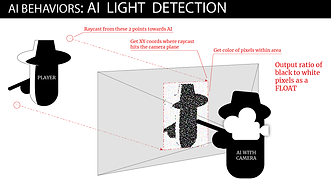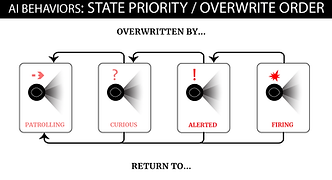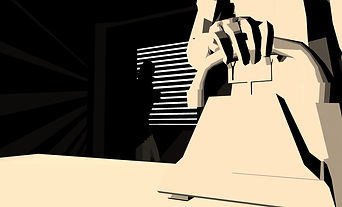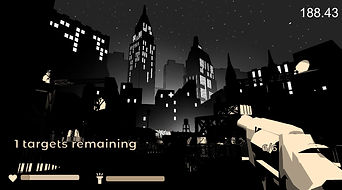

Available on Steam and on itch.io
Since my first day at Champlain College, my goal was to pitch SCORCH to my senior year team; to do everything I could to get the concept through greenlight and turn it into a finished game. The game has changed and evolved much since that original vision, and I'm incredibly proud of what it has become and where it has landed.
What is SCORCH?

SCORCH started as a design challenge to myself, all the way back in high school. How would I go about making stealth a viable, optimal strategy for a player-vs-player first person shooter. My solution was to move away from any coded, systems-based solutions and to create something more emergent. By utilizing a shader reduces the lighting cast on the environment to hard edges shadows of complete black, players may step into shadows and essentially become completely invisible.
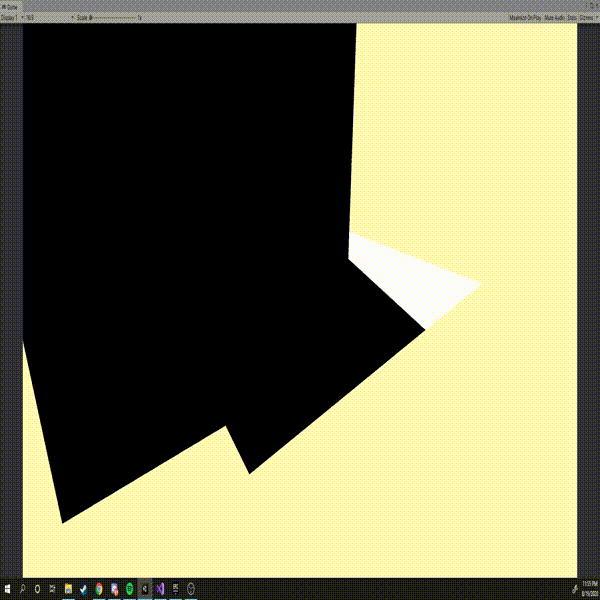

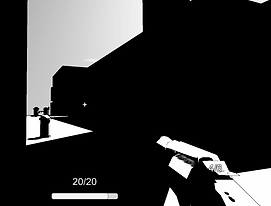
Development on SCORCH began with a five person team. Though the concept was for a multiplayer game, no one on the team had any experience with networked development, so we decided to start with a single-player prototype.
As the sole designer, I was responsible for most of the final decisions when it came to systems, narrative and level design. I was in constant communication with each team member, taking in their input every day, ensuring everyone's voice was heard and contributed to the best possible final product.
Level design was particularly challenging. Normal level design is already difficult. In SCORCH, it was critical to also consider exactly how much shadow was cast onto the environment. To little, and the game would lose its the intended stealth. Too much, and it would be too difficult for the player to identify their surroundings, navigate, or spot enemies.

During this phase of development, I was also able to pick up various art and programming odd jobs that the rest of the team didn't have time to get too. One of my greatest contributions was creating the trailer for the greenlight presentation. I wrote a short script and got a friend of my dad's named Dave Crandall to do the voice over. My writing and video work combined with his gravelly voice surprised everyone at the greenlight presentation and seriously contributed to us moving on to the next phase of development.
After SCORCH made it through greenlight, we were scaled up to a fifteen-person team, and my role as lead designer become much more difficult than I expected. I wasn't able to keep as personally in touch with each team member as I was used to, and a lot of development began happening completely outside of my purview. Fortunately we had a team of extremely capable artists, programmers and designers, and though I kept my eye on the direction the project was headed, much of the development went completely smoothly without my direct involvement.
As we decided to continue with a single-player game instead of attempting the switch to multiplayer, many new challenges arose. Creating believable and challenging AI was absolutely crucial, and I put a lot of time into designing there behaviors and documenting the intent for the programmers.
Narrative was the second biggest challenge. With the focus to single-player it was important that we come up with an engaging story to contextualize the gameplay. The team had agreed on the film-noir aesthetic very early on because it fit so well with the lighting system. However, classic-film noir is very action light, and so it became very difficult to come up with a story that fit both thematically and mechanically with our FPS systems. Fortunately I was no longer the only designer on the team, and together we were able to come up with the systems and the script we needed.
Plenty of other design and development challenges arose along the way. We switched strict black-and-white to multi-stepped lighting to make navigation easier on players. It took a lot of time to come up with a tutorial that was clear and easy to navigate, and the player objective system was also difficult to realize. I continued to pick up odd jobs outside of just design. I built the skyline that caught alot of people's attention. I programmed a speed run timer that was originally just for use within the team, but that we kept in the final product when it turned out to be really fun in QA testing.
In the end, though SCORCH is completely different from the military-themed arena shooter I first envisioned, I am incredibly happy with how it turned out. I was overjoyed to see how everyone's input shaped the final product. The reception of it's release on Steam has been incredible: players enjoy playing it, and above all, have said they want more. I hope one day we get the opportunity to give them that.
